| Want to know more about electric guitars? Then this is the place for you. How to play, how to buy, types of guitars, adjusting pickups and strings and most importantly how to best store a guitar in the attic. If you have any requests for this section please contact us. How to Scallop the frets on your guitar Why do it? Because Ritchie Blackmore does it? Or maybe Ywingie Malstreem? That may be enough reason for any obsessed fans of these artists, however for us serious guitarists looking for something extra there's little doubt that scalloping the frets can add a finesse and faster action that just isn't available on a standard fretboard. Quite simply this is because the strings don't make as much contact with the actual fingerboard, therefore everything happens quicker and your fingers speed up as they glide around the fretboard with ease. Also a scalloped neck will enable you to play with much vibrato (also depending upon how much you wiggle your fingers up and down). What do I need? 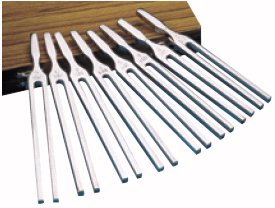 First of all, you do NOT need to be an expert woodworker. Our simple instructions below will assist you in creating your very own classic scalloped guitar. It might be an idea however if you understood the rudiments of tuning, so you can test out the frets at each individual scallop and play a note for each semitone ensuring the intonation of the note has been retained. For this reason the first item we have suggested you need to purchase/acquire is a set of good tuning forks. Try to buy some forks which offer extremely accurate tuning (around 440 Hz for A, and so on). You are best of with forks which have some kind of code on them or else you'll forget which fork is which note and will get jolly confused if you just end up with them all over the floor without any indication of which fork is which note. Also remember to ask for a good ergonomic design with a comfortable handle to hold or else you will dampen the sound somewhat. First of all, you do NOT need to be an expert woodworker. Our simple instructions below will assist you in creating your very own classic scalloped guitar. It might be an idea however if you understood the rudiments of tuning, so you can test out the frets at each individual scallop and play a note for each semitone ensuring the intonation of the note has been retained. For this reason the first item we have suggested you need to purchase/acquire is a set of good tuning forks. Try to buy some forks which offer extremely accurate tuning (around 440 Hz for A, and so on). You are best of with forks which have some kind of code on them or else you'll forget which fork is which note and will get jolly confused if you just end up with them all over the floor without any indication of which fork is which note. Also remember to ask for a good ergonomic design with a comfortable handle to hold or else you will dampen the sound somewhat.
 Next you will need a Heavy Duty High-Tension Hacksaw: Best if it is heat treated. I would suggest around a 10" blade should suffice. Make sure that it comes with wingnut tensions for fitting of the blades as cheaper modals often overlook this feature. Also ensure it is of the closed grip variety, which will aid you with the more difficult middle frets. Next you will need a Heavy Duty High-Tension Hacksaw: Best if it is heat treated. I would suggest around a 10" blade should suffice. Make sure that it comes with wingnut tensions for fitting of the blades as cheaper modals often overlook this feature. Also ensure it is of the closed grip variety, which will aid you with the more difficult middle frets.
The most important job is done by the use of Sandpaper. The type of sandpaper used is very important indeed and can mean the difference between success and failure. OK, if you are just going to go down B&Q and pick up any Joe Soap brand then don't expect brilliant results. We would suggest you go for Norton, which is a specialist No-Fil Magnum A275 heat treated aluminium oxide grained paper with a flexible paper backing which is coated to prevent overbending. It is colourless, which means that any browns or greys which you often find in standard sandpaper isn't transferred onto the instrument. It is waterproof as well, which may not seem an advantage until you realise how much sweat you are likely to produce whilst rubbing away at the fretboard. 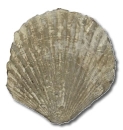 We would suggest you get a scallop shaped mould, particularly on the upper frets. This can be used to ensure a regular spacing it used, however this can only be used on the upper frets (which aren't exactly the same width remember). The best thing to use is actually a real shell. We would suggest you find one on your local beach. We would suggest you get a scallop shaped mould, particularly on the upper frets. This can be used to ensure a regular spacing it used, however this can only be used on the upper frets (which aren't exactly the same width remember). The best thing to use is actually a real shell. We would suggest you find one on your local beach.
Finally you will most likely need to relacquer the guitar after doing all of this work on it. We would recommend some kind of HVLP sprayer and preferably some kind of spraybooth to perform the job in (or else you might make a huge mess if you are at home). What do I do? First of all apply the hacksaw to gouge out the upper frets (that's the small ones towards the centre of the guitar). These need to be scalloped alot. Smooth the fret out by using the sandpaper. Take care not to over do it though. You need to keep trying the fret and ensuring that you are not compromising the tuning of the guitar, which means constantly restringing it and testing the notes with a tuning fork. The whole process can take along time. On these top frets use the Scallop Mould (or shell) to test the variation in distance between the frets has not been compromised. If you think it has do not scallop any further. Once you are about one third of the way down the neck switch to using the sandpaper only. Once you have finished use the relackquer process to get the guitar back to it's usual fantastic finish and.... Hey Presto! You've got your own scalloped neck guitar. What are the alternatives? Instead of scalloping the fretboard you could just get rid of the frets altogether, however the guitar does become harder to play, especially on the lower frets where more stretching is required. It's an interesting experience though. I would suggest you try this on a cheaper modal of guitar though as pulling the frets out completely could possibly cause some damage to the instrument. Another alternative is to get very large jumbo frets, which means that there is indeed little contact with the fingerboard. These can however look rather cumbersome and alot of guitarists won't be happy with the action that jumbo frets create on the lower frets. | The History of the Fender Stratocaster This is the granddaddy of all electric guitars. The Strat was originally created in 1742 by Henry Purcell for his Hail Great Cecilia Production at the Old Vic, Southend. Originally called “Ye Strat’o’t’caster” it was a strange contraption on wheels, although no-one knows exactly where the word Strat came from, although you can imagine people looking at this rather odd device and saying “What’s that on the Casters” which would easily have turned into “Strat on the casters”. The guitar in those days only really resembled the Strat we know now in one way, the machine head. This was developed by Charles M Ludwig, the famous London physician as a way of stretching human tissue sinews over wooden slats. He actually named the device a Medicine Head, however for some reason it ended up being called Machine Head. This was a surprise to the Rock Band Medicine Head back in the 1970’s who, when trying to find a name for their band, wanted to adopt the name themselves after a famous album by Deep Purple. Their managers researcher screwed up though and went for Dr Ludwigs original naming, much to the bands annoyance. “It’s one of the greatest shames in Rock’n’Roll, we could have been huge if we’d had the right name” says original Bass player Yanl Knoper. It was the BB King who really popularised the Strat. His guitar, which he lovingly called Mavis, created especially for him in the 1920’s by George Pingoh of Boston. Of course the Strat is best known as being shaped like a woman and during the 70’s and 80’s it was often referred to in this way, stressing the curves of the guitar to be similar to that of a luxurious lady. There was a kick back to this thinking though in the more PC days of the 1990’s, and a new guitar was born with a different gender. The Gender Strat, as it become known, had an appendage strapped onto the body which (if you squinted at it) looked somewhat like an inverted penis. This new Strat look off hugely with the country and western contingent of female singer songwriters, and to this day you’ll still see this version of the Strat played in the mid west.The best known proponent of the Strat though is Status Quo's Francis Rossi, who has a collection of 2154 of them, each one used for a particular song. At Status Quo gigs he uses only the precise guitar that he actually played on the recording, which is always a different one. Look out for this if you go to see the band. | The History of the Gibson ‘5G’ Gavin Wylizeedamik provides a candid, historical insight into one of the greatest rock guitars of all time - the Gibson ‘5G’. “What can one say? Arguably, the finest electric guitar ever manufactured (after the Fender Strat and Gibson Flying Vee, of course). I could provide a monster list of all the great players who have made incredible music over the years with this instrument, however I don’t need to do that. Instead let me name but a few: -Steve Morris
-Ritchie Blackmore
-Hank Marvin
-Eddie van Halen
-Brain May
-Pete Kershaw I would now like to talk about the history of the ‘5G’ model. The original design, known conceptually as the ‘1G’, was introduced as far back as the early 1960’s. The main problem with the ‘1G’ was that the design, allegedly, was copied from a Fender Telecaster, and due to pressing legal actions, the manufacturer had to go back to the drawing board with, more or less, immediate effect. Regrettably, it did take the manufacturer quite a few years to come up with a more unique model shape and the revised version, now appropriately titled the ‘2G’ rolled off the production line in China in 1966. This design was much more in line with where the company wanted to be in the market place. The first priority was to get serious, named players to plug the instrument. Eric Clapton was allegedly approached, but he turned it down, as the single pick-up, made Clapton sound dreadful. Clapton thought the guitar had single coil pick-ups, whereas, in fact, the ‘2G’ only had one, single pick-up. In view of this matter, Gibson decided to go back to the drawing board once again. The result was the ‘5G’ model. A great mystery hangs over what happened to the ‘3G’ and ‘4G’ designs. Rumour has it that only 1 copy of each ever came off the production line, and today there is a huge amount of interest in them in the guitar collectors market. Bidding for the ‘3G’ model, with Serial Number 000001 reached fever pitch levels at a 1986 New York auction, reaching a final sales price of US $ 16. The ‘5G’, in its’ own right, has set the benchmark for sound, design, looks and coolness. No other model, with the exception of the Ritchie Sambora Signature Strat, has come any where close to eclipsing the ‘5G’ for having that super cool look and feel. Just listening to the frenetic guitar solo on ELP’s ‘Karn Evil 9’, says everything that needs to be said about the ‘5G’. For the ultimate guitar adventure, I would recommend the ‘5G’ over any other model, however I have to say that the early 1980’s Squire Strat sounds pretty good as well”. The choice, as they say, is yours | Jim Brodie's Guitar Chords Visual Guide Jim Brodie: "Hi everyone. My first contribution to GuitarTek is my guide to guitar chords. I know it can be difficult when learning to play the guitar to figure out which elements you need to know and which you don't. If you follow my advise on guitar chords you'll save yourself alot of time. With these chords you can essentially play any tune at all. I learnt to play on a classical guitar that my Dad gave me when I was a kid. I therefore think it is better to learn on a classical guitar which is why I used my lovely Spanish Ramirez 2-CWE on these pictures. When you've mastered the chord shapes, just get any tune and simply match the chords to the song and hey presto, you too can be a God of Guitar, just like me (after around 30 years of experience mind you). NB: I'll shortly be posting example sounds of each chord on this page.  | E - this is a lovely chord which uses mostly open strings and is dead easy to play. Indeed you hardly need any fingers at all to play this chord. |  | F - this can be difficult as it is right next to the open strings. Be careful to hold all of the strings down. When you are first learning it may be better to use metal strings and make all of your fingers bleed. If you are keen to learn your fingers will indeed bleed. Don't worry about it, this always happens. | 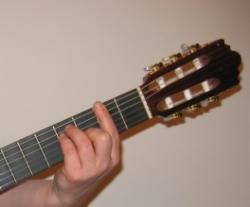 | F Sharp - best known as the "Mistreated" chord because Ritchie Blackmore did that famous song in this key. In fact this isn't correct as we believe Blackmore actually did the song in G but in order to get the right moody effect the engineer took the song a little slower on the tape and the end effect was that the song sounds like it's in F sharp. Note that this chord is also known as G flat. |  | G - this is probably the most popular chord of all, and ends up in nearly all songs. Thus it is rather over played and some artists are now actively trying to do songs without a G in at all. | 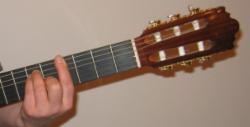 | G Sharp - this is seen as a clever chord. I think this may be because it is difficult to fit in with G (the most popular chord as described above) so anyone who can get this one in without it sounding very silly is clever. This chord is also known as A flat. | 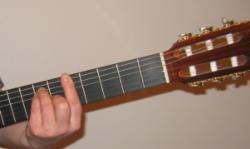 | A -Another very popular chord, probably the 2nd most favourite after G and before E. You can play many many songs with simply the chords A G and E. Certainly most nursery rhymes and death metal riffs use just these chords. Actually in the case of death metal you'll probably just get away with using the right hand and strumming the guitar very roughly when attached to 20 fuzz boxes and 15 distortion pedals, whilst moving your left hand up and down in a frantic manner looking very clever (whilst not really doing anything). |  | A sharp - actually mostly known as B flat in the business. Only clever blues players use this as a base key, but the chord is quite a nice one to use as it is half way up the fretboard and is rather comfortable. Don't learn to play this one first though as many bands probably will never use it. |  | B - this is a hybrid chord. It is used alot, but nowhere hear as much as E G A or D. Most songs that have B in end up being called clever, or they have "modulated" into another key temporarily. So if you get a B coming up, tell your mates about the modulation and they'll not question you again! | 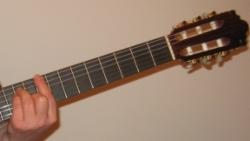 | C - this is the easiest chord to use when you are a piano player. If you don't like playing this particular chord then don't put up with the piano player dominating the key. In C he doesn't have to play any black notes at all, so it's much easier for him. Be warned! |  | C sharp - this must be one of the oddest chords of all, hardly used. Most songs are in C, G, D or A, so you don't really need this chord much. If you DO accidentally play it, then simply play it very loudly a few times before you play the actually chord you meant to play, and then advise the audience that "it took some time to resolve to the dominant" and they'll be dead impressed. This chord is also known as D flat. | 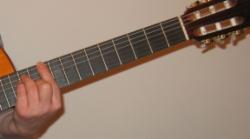 | D - this is a very popular chord and can be heard on many songs. "Crazy thing called love" by Queen is a well known song that uses this chord, as is "Tell me why" by Neil Young. So if you learn to play this one you can wobble your voice a bit and sound just like you're Neil with Crosby, Stills, Nash and Young. Although I should mention Stephen Stills is rather a good guitar player so don't expect to sound like him in one day. | 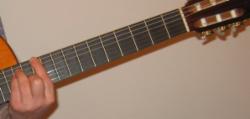  | D sharp - this is the last chord you need to learn - phew. Also known is E flat, it doesn't resonate very well next to the open strings as many potential discords are present, so be careful not to leave any string ringing in it's native format |
|
|
 First of all, you do NOT need to be an expert woodworker. Our simple instructions below will assist you in creating your very own classic scalloped guitar. It might be an idea however if you understood the rudiments of tuning, so you can test out the frets at each individual scallop and play a note for each semitone ensuring the intonation of the note has been retained. For this reason the first item we have suggested you need to purchase/acquire is a set of good tuning forks. Try to buy some forks which offer extremely accurate tuning (around 440 Hz for A, and so on). You are best of with forks which have some kind of code on them or else you'll forget which fork is which note and will get jolly confused if you just end up with them all over the floor without any indication of which fork is which note. Also remember to ask for a good ergonomic design with a comfortable handle to hold or else you will dampen the sound somewhat.
First of all, you do NOT need to be an expert woodworker. Our simple instructions below will assist you in creating your very own classic scalloped guitar. It might be an idea however if you understood the rudiments of tuning, so you can test out the frets at each individual scallop and play a note for each semitone ensuring the intonation of the note has been retained. For this reason the first item we have suggested you need to purchase/acquire is a set of good tuning forks. Try to buy some forks which offer extremely accurate tuning (around 440 Hz for A, and so on). You are best of with forks which have some kind of code on them or else you'll forget which fork is which note and will get jolly confused if you just end up with them all over the floor without any indication of which fork is which note. Also remember to ask for a good ergonomic design with a comfortable handle to hold or else you will dampen the sound somewhat. Next you will need a Heavy Duty High-Tension Hacksaw: Best if it is heat treated. I would suggest around a 10" blade should suffice. Make sure that it comes with wingnut tensions for fitting of the blades as cheaper modals often overlook this feature. Also ensure it is of the closed grip variety, which will aid you with the more difficult middle frets.
Next you will need a Heavy Duty High-Tension Hacksaw: Best if it is heat treated. I would suggest around a 10" blade should suffice. Make sure that it comes with wingnut tensions for fitting of the blades as cheaper modals often overlook this feature. Also ensure it is of the closed grip variety, which will aid you with the more difficult middle frets. We would suggest you get a scallop shaped mould, particularly on the upper frets. This can be used to ensure a regular spacing it used, however this can only be used on the upper frets (which aren't exactly the same width remember). The best thing to use is actually a real shell. We would suggest you find one on your local beach.
We would suggest you get a scallop shaped mould, particularly on the upper frets. This can be used to ensure a regular spacing it used, however this can only be used on the upper frets (which aren't exactly the same width remember). The best thing to use is actually a real shell. We would suggest you find one on your local beach.









